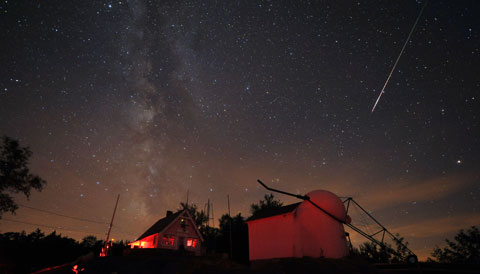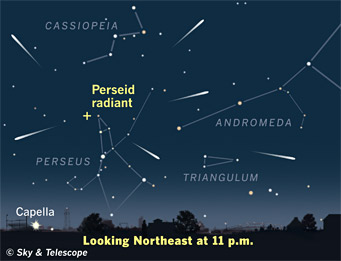A SKY & TELESCOPE PRESS RELEASE
Contact:
Alan MacRobert, Senior Editor, Sky & Telescope
855-638-5388 x2151, [email protected]
Kelly Beatty, Senior Contributing Editor, Sky & Telescope
617-416-9991, [email protected]
| Note to editors/producers: Two publication-quality images are available; click on the links in the captions of the thumbnails below. A video animation is available at the bottom of this page. More information for the public is available at SkyandTelescope.com/perseids2014. |
The Perseid meteor shower, an annual celestial event beloved by millions of skywatchers around the world, is returning to the night sky for 2014 But this year it will compete with bright moonlight for visibility.

Sky & Telescope magazine predicts that the Perseid shower will be at or near its peak late on Tuesday night, August 12-13 (from late Tuesday evening until dawn Wednesday). "But this year the Moon will be just two days past full on the peak night, so moonlight will fill the sky," says Alan MacRobert, a senior editor at Sky & Telescope. "The moonlight will hide many of the fainter meteors. But the bright ones will still shine through."
A recent NASA analysis of all-sky images taken from 2008 to 2013 shows that the Perseids deliver more bright meteors (those that outshine any star) than any other annual meteor shower.
An occasional Perseid may catch your attention early in the evening, but the prime viewing hours are from about 11 p.m. or midnight (local time) until the first light of dawn. This is when the shower's “radiant,” its apparent point of origin, is high up in your sky. The higher the radiant, the more meteors streak into the Earth's upper atmosphere all over the sky.
To enjoy the Perseids, you need no equipment but your eyes. Find a dark spot with a wide-open view overhead. Bring a reclining lawn chair or a ground cloth so you can lie back and watch the sky in comfort. Face away from the Moon. Bundle up in blankets or a sleeping bag, both for mosquito shielding and for warmth: clear nights can grow surprisingly chilly under the open stars (due to radiational cooling).
“Relax, be patient, and let your eyes adapt to the dark,” says MacRobert. “Even with the moonlight, you'll probably see a ‘shooting star’ at least every five minutes or so on average.”

When you see a meteor, track its path backward. If you eventually come to the constellation Perseus — which climbs the northeastern sky as the night progresses, as seen at right — then a Perseid is what you’ve just witnessed.
Occasionally you may spot an interloper. The weaker Delta Aquariid and Kappa Cygnid showers are also active during Perseid season, and there are always a few random, “sporadic” meteors. All of these track back to other parts of the sky.
Perseid Meteors: How and Why
Meteors are caused by tiny, sand- to pea-size bits of dusty debris streaking into the top of Earth's atmosphere about 80 miles up. Each Perseid particle zips in at 37 miles (60 km) per second, creating a quick, white-hot streak of superheated air. Grape Nuts cereal nuggets are a close match to the estimated size, color, and texture of typical meteor-shower particles.
These particular bits were shed long ago by Comet Swift-Tuttle. They are now distributed all along the comet's orbit around the Sun. Earth passes through this tenuous "river of rubble" every year in mid-August.
More about the Perseids and how to watch them appears in the August issue of Sky & Telescope magazine and at SkyandTelescope.com/perseids2014.
Anyone can download Sky & Telescope's ebook, Shooting Stars. It's free!
For skywatching information and astronomy news, visit SkyandTelescope.com or pick up Sky & Telescope, the essential guide to astronomy since 1941 with subscribers in more than 100 nations. In addition to Sky & Telescope and SkyandTelescope.com, the company publishes two annuals (SkyWatch and Beautiful Universe) as well as books, star atlases, observing guides, globes, apps, and other astronomy publications.
Video file:
Video animation (TRT 00:15, MOV file) of simulated meteors in the northeast sky view. Think of this as a time-lapse video; the meteors won't happen nearly this frequently in real time!
 0
0









Comments
You must be logged in to post a comment.